
15 minute read
Judged To Be Efficient


Advertisement


The Beaux Arts-style courthouse in Muscatine, IA, uses a VRF/geothermal integrated HVAC system from Mitsubishi Electric Cooling & Heating.
Judged To Be Effi cient


Integrated VRF and geothermal systems save energy for an historical courthouse.
Muscatine, IA is home to a Beaux-Arts-style courthouse constructed in 1907 and listed on the National Register of Historic Places in 1981. According to county budget director Sherry Seright, there were growing signs that the building’s more than 30-year-old cooling and heating system needed to be replaced. “We found water in the basement from the old boilers, and the pipes were starting to leak. The indoor units were loud, moldy, and fuzzy, and everyone disliked the huge, ugly condenser unit sitting prominently on the roof of our handsome … building, spoiling the view,” she said.
Searching for green
The County Board of Supervisors wanted to learn more about going green and knew it was time to replace the courthouse’s failing, outdated HVAC system. A proposal from Vic Amoroso, a 40-year HVAC design engineer and president of A&J Associates PC, North Liberty, IA, caught their attention. Amoroso explained the basics of a closed-loop geothermal system and how smoothly it would work in tandem with a variable-refrigerant-fl ow (VRF) zoning system from Mitsubishi Electric Cooling & Heating, Suwanee, GA.
Bruce Senti, an independent sales representative from Mitsubishi Electric, explained to Amoroso how the VRF zoning water-source system would interface with a geothermal fi eld. “Our new W-series modular units perfectly combine the energy effectiveness of geothermal systems with the excellent effi ciencies of our VRF zoning technology,” said Senti. “These new units are 30% smaller than previous models and can be easily transported down the stairs into the basement of the courthouse. By connecting to the geothermal loop, backup heat would not be needed as it might with air-source units.” The system, which uses water instead of air as a heat-exchange medium, is superior to air-cooled systems, especially in Iowa, where it is not uncommon for winter temperatures to dip below –10 F. The system’s dry mode is effective for the months of July and August, which can make Iowa feel like a greenhouse.
Because of the hot, humid Iowa summers, Senti recommended another key VRF zoning product, a Mitsubishi Electric City Multi dedicated outdoor air system (DOAS). The DOAS would supply outdoor ventilation air to the courthouse, delivering the proper amount of fresh air to each room, and also provide ample dehumidifi cation without excessive reheat. The DOAS would also increase the VRF zoning system’s energy effi ciency because it pre-conditions outside air for introduction into the downstream HVAC units, reducing the load on the HVAC system.
The fact that the DOAS and the VRF zoning system were designed to work together was appealing to Senti. “The DOAS from Mitsubishi Electric was very convenient for us,” he said.
“Because the outdoor-air system and the VRF system were manufactured by the same company, we didn’t have to cobble together a system with components from different manufacturers that might decrease the system’s energy effi ciency. Additionally, this system combination provided us with a one-stop shop regarding parts, warranties, installation, service, and repair.” Amoroso was interested in the VRF zoning system because its engineering design would overcome the installation challenges posed by the 105-year-old building with its 24-inch-thick limestone walls. The gas-fi red boiler supplying heat to the courthouse would be eliminated, providing the county with signifi cant natural-gas savings in the winter. But Amoroso also saw something even more signifi cant—the VRF zoning system effi ciencies, coupled with the heat-sync exchange of the campus geothermal fi eld, could serve the courthouse and the new jail addition across the street. The geothermal campus was a hybrid, closed-loop system with 60 vertical and 40 horizontal wells. Amoroso’s presentation to the board convinced the members that this was the right decision.
Order in the court
The transition to the new system was smooth, with not one courthouse offi ce losing a day of work. Judges even held court during the transi


tion. Mechanical contractor Heath Allard, president of Climate River Valley, Eldridge, IA, said, “This smooth installation had a lot to do with the native intelligence of the Mitsubishi Electric VRF zoning system design. Because it’s the industry’s only two-pipe system, there are far fewer fi ttings on the refrigerant lines, which saved us a lot of labor and equipment costs. Because the
The courthouse is listed on the National Register of Historic Places and now boasts an updated HVAC system that saves energy and money.


W2-series units are installed indoors, we did not have to drill through the thick limestone walls, which would have made quite a racket.”
“There are so many benefi ts to this new system it is hard to know where to begin,” Amoroso said. “First of all, there is the historic preservation accommodation of this technology, which is the least intrusive, less destructive factor
DORMA ACCESS SOLUTIONS —



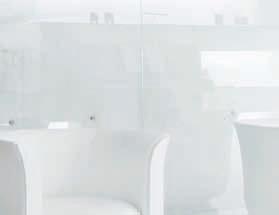
www.dorma.com
Enabling better buildings
DORMA is a market leader of innovative and inspiring designs and technologies for access solutions. DORMA features a design oriented portfolio of architectural door hardware, specialty hardware for glass door and wall applications, door automation systems including Crane revolving doors, operable wall systems featuring Modernfold, and electronic access control systems with Rutherford Controls.
Opening & Closing Securing


Dividing

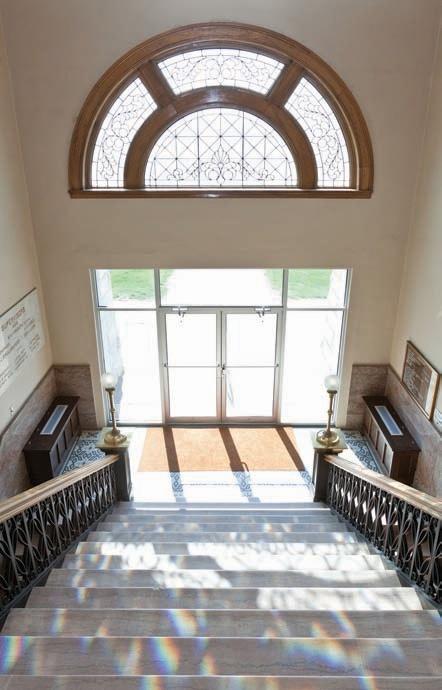



Historic preservation was important for a new courthouse HVAC system. Mitsubishi Electric’s two-pipe system installation was non-intrusive.
of this two-pipe system. There is the super-quiet aspect of all the indoor units, ideal for an offi ce environment: It’s so quiet, people often ask if it is operating. There is the system’s remarkable ‘dry mode’ setting, which has great impact on indoor comfort during our humid summers. Then, there is the unique 100% inverter-driven compressor that varies its speed to match the indoor cooling or heating demand. This is great engineering. When the system is operating at partial load, the energy effi ciency is signifi cantly higher than that of a standard fi xed-speed system.”
Inside the buildings, the VRF zoning-system heat pumps recover excess heat and reuse it to heat cold spots and to warm water. When the building temperatures are satisfi ed, the excess heat is then shared with the second building served by the campus geothermal loop. The second building’s heat-pump system uses the shared energy to maintain the temperatures in the jail addition. If both building temperatures are satisfi ed, then the excess heat is transferred to the loop fi eld to be stored for later use. This use of a single energy unit provides overall campus energy savings. “We sized the geothermal loop fi eld to handle 450 gallons/minute fl ow at the design heating and cooling load,” Amoroso continued. “The geothermal pumps are variable speed and
Brick • Permeable Pavers • Asphalt Block • Garden and Landscape Walls ® Pavers • Roof and Plaza Pavers • Prest ® Prest Historic South Capitol Park, Harrisburg, PA

Hanover ® Asphalt Block

Produced with Recycled Content, Asphalt Block is a unique paving alternative helping to earn SS Credits and LEED points. Available in several shapes, sizes and colors, Hanover ® Asphalt Block will enhance any project.



www.hanoverpavers.com • 800.426.4242
Equipment Installed

VRF equipment from Mitsubishi Electric Cooling & Heating, Suwanee, GA, installed at the Muscatine (IA) County Courthouse includes:
One PURY R2-series outdoor unit
Six PQRY WR2-series outdoor units
Six PLFY ceiling-concealed indoor units
Eight PKFY wall-mounted indoor units
Fifty-seven PFFY fl oor-standing concealed indoor units
One PEFY dedicated outside air system (DOAS)
Fifty-eight PAC Simple MA remote controllers
Eleven PAR MA remote controllers

Seven CMB branch circuit (BC) controllers
Two AG-150A centralized controllers.
adjust to what is needed in the overall campus balance. We have observed this past summer that the fi eld can handle the campus system heattransfer requirement with just 20% of the design fl ow. The savings in pumping energy alone has been tremendous. This result is due in large part to the ability of the courthouse VRF zoning system to share and save heating and cooling energy for use in the other building and for storing for later use.”
Positive verdict
“We are all thrilled with the performance of this technology partnership,” Seright said. “As budget director, I can tell you the clearest proof of the success of our decision came when the 30,000-sq.-ft. new jail addition came online and was tied into the campus geothermal fi eld between both buildings. The energy bill did not move up one tick! That’s amazing proof of how this technology works.”
“Perhaps best of all, we were able to remove that hideous chiller on the courthouse’s roof that spoiled its classic lines,” she continued. “The diminutive demands of this VRF zoning system have helped us bring back the grandeur of our courthouse.”
for free information, CIRCLE 16
and visit our digital magazine at www.cbpmagazine.com/digital/julaug2013 and click on the icon.
Museum Creates Rock Stars With Tile, Granite
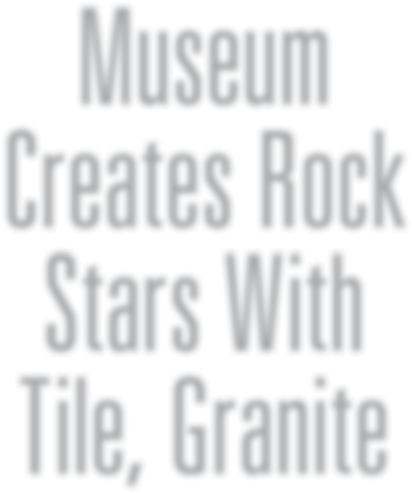


Use of a Laticrete system contributes to the beauty and durability of an interactive research lab.
One of the most popular exhibits at the Nature Research Center is the Daily Planet, a threestory globe of the earth.


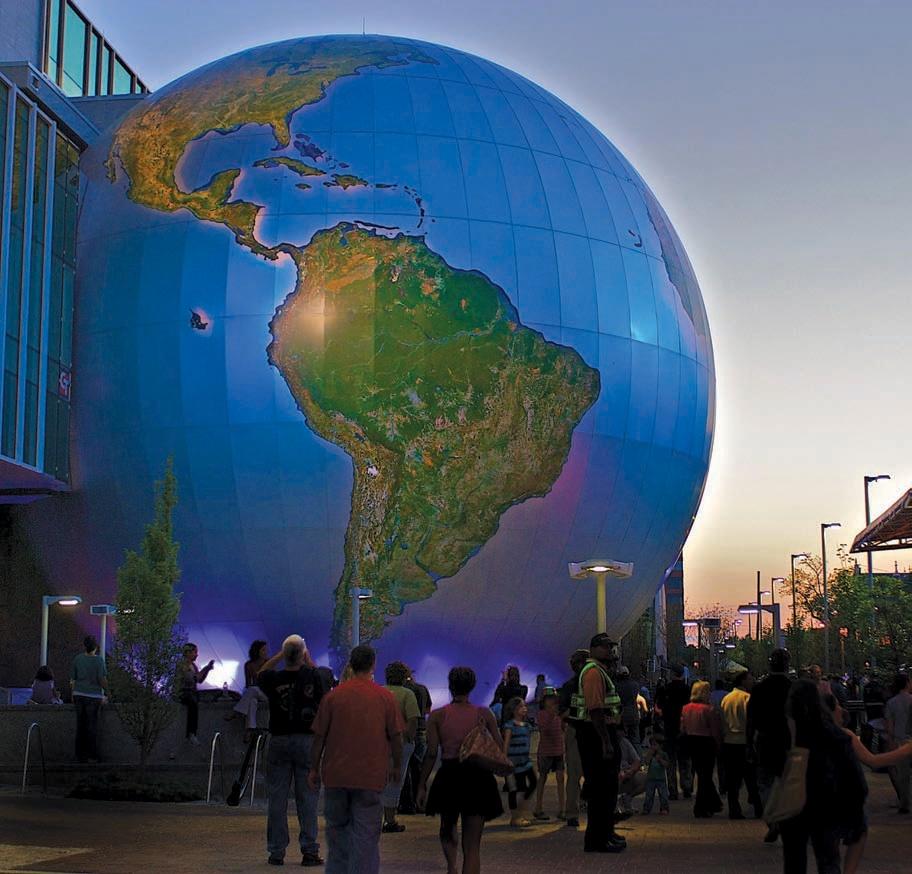

The North Carolina Museum of Natural Sciences’ new Nature Research Center wing, a state-of-the-art 80,000-sq.-ft. building with its cornerstone three-story globe of the earth, The Daily Planet, opened in late April 2012 in Raleigh. Its declared mission was to bring research scientists into the public eye, demystify what can be an intimidating fi eld of study, and ultimately inspire educators and students toward a new generation of young scientists. According to the museum’s communications director, Jon Pishney, “Traditionally, museums show us more about what we know. Our new Nature Research Center gets visitors so involved they leave after learning via hands-on processes.”
Designed to meet LEED Gold criteria, the new wing offers highly visible research laboratories where qualifi ed scientists conduct research projects while visitors are right next to them, observing and learning. Additional investigative labs offer visitors a chance to perform their own small-scale experiments and try their hand at using tools of the trade.
“This way, we’re able to get visitors more directly involved in the scientifi c process,” added Pishney. “It’s very possible at the Nature Research Center for a museum guest to use a high-powered microscope to look at plant or animal cells hundreds of times bigger than life.”
The Nature Research Center is connected to the existing museum with a two-level pedestrian bridge. The upper story features a progression of handmade tiles, created by artist Barbara Page, positioned along handrails to represent the passage of geologic time. In a nutshell, one can start at one end of the bridge and see tiles portraying life forms dating back 542 million years. By the time he or she gets to the other end of the bridge, the tiles impart images of living creatures that have evolved from back then until right now.
Teamwork pays off
“These exterior hand-made tiles were installed in a stainless-steel pan,” said Jason W. Banks, LEED AP, project manager, BD+C at David Allen Co., an NTCA 5-star contractor and CTEF certifi ed installer with headquarters in Raleigh, NC. “We knew from the start that working with the museum would involve a number of very unique tile projects. That’s why we trusted the Laticrete System for all installation materials. We used Latapoxy 300 adhesive for the handmade ‘time tiles’ due to its bonding strength. We caulked the entire perimeter and joints of these with Laticrete Latasil highperformance silicone sealant. Glass tile at the café was installed with Laticrete 254 Platinum. Before bathrooms were tiled, we protected all substrates by waterproofi ng them with Laticrete Hydro Ban. Each time, the outcome was perfect.” All products are from Laticrete International, Bethany, CT.
The team from David Allen worked throughout specifi c areas within the new wing, primarily using Dallas-based Daltile products in the main bathrooms, kitchen, and café. Horizontal granite was specifi ed for the main lobby entrance and as stair treads on the monumental fl oating staircase. “Great coordination work was done by the general contractor, Clancy & Theys Construction Co. of Raleigh, to get the main lobby and kitchen areas completed on time. The glass barrier around the edge of the fl oating stairs, for example, could not be put in place until the granite treads and landings were installed,” said Banks.
“When it comes to the selection of products, our hands are tied here a bit, as the architect dictates what tile materials they intend and specify as a basis of design,” Banks said. “The architectural fi rm that designed the Nature Research Center, O’Brien/Atkins Associates PA [Durham, NC], did an outstanding job choosing products that were both beautiful and functional, while at the same time qualifi ed for LEED points. “With my knowledge as a LEED AP BD&C, I understand the LEED scorecard and thus can properly fi ll out the paperwork for the GC. This helps streamline the process a bit for them. It also helps when looking to collect LEED points within the materials selected. While the specifi cation may indicate only a regional requirement for the product, I can research the product and perhaps add to the recycling content LEED point.”





▲
A series of handmade tiles represent the passage of geologic time. Visitors can follow tiles portraying life forms dating back 542 million years.



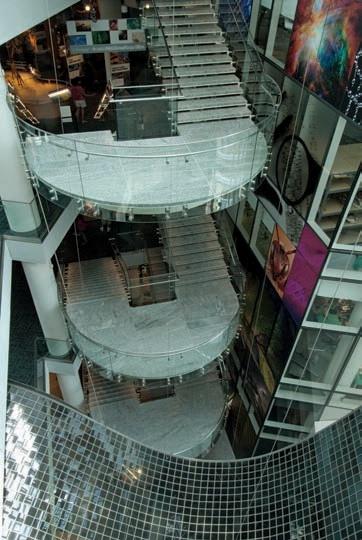


▲
Granite serves as the treads on the monumental fl oating staircase. Despite the visual weight of the stone, the glass barriers around them create the illusion that the slabs are fl oating.
Rock stars
One area where Banks had some leeway was the choice of setting materials used. He explained that the LaticreteSystem was a great choice for this project due to optimal performance and the convenience of the company’s Hamlet, NC, location. “That allowed most of the installation products used to contribute to the regional-materials LEED certifi cation.”
Greene County granite and Virginia Mist granite were fabricated by North Carolina Granite Corp. in Mt. Airy, NC. Again, because the materials were shipped from their source location less than 500 miles from Raleigh, points were added to the project’s LEED scorecard.
For the museum’s 24-hour grand opening, more than 1,000 people stood in line, waiting 45 minutes for a chance to go inside the threestory globe that had gradually taken shape over the past year. Many were interested in the center’s philosophy of getting visitors interactively involved with scientists. “We’re taking scientists out of their lab coats and isolated labs and putting them into the spotlight,” said Meg Lowman, director of the center. “They are the new rock stars.”
The North Carolina Museum of Natural Sciences’ Nature Research Center has moved its tile-and-stone installation into a veritable spotlight position, as well. “Believe it or not,” Banks concluded, “there is a great deal of scientifi c know-how involved in these various tile projects. Maybe someday, a technical-services guru from Laticrete will be on hand in this building, offering cutting-edge information to a young, interested generation of potential tile-installation professionals about the correct ways to install tile and stone.”








